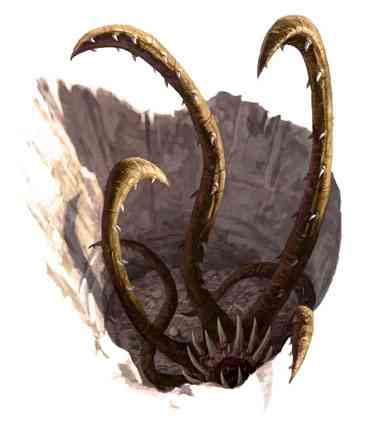

FREQUENCY: Uncommon
FREQUENCY: Uncommon ([Temperate
Wilderness Desert])
FREQUENCY: Very rare ([Temperate
Wilderness Plains])
FREQUENCY: Very rare ([Tropical
Wilderness Plains], [Tropical Wilderness Desert]) <x>
NO. APPEARING: 1-20
ARMOR CLASS: 4
MOVE: 3"
HIT DICE: 4
% IN LAIR: Nil
TREASURE TYPE: Nil
NO. OF ATTACKS: 1
DAMAGE/ATTACK: 1-8 + AC
of victim
SPECIAL ATTACKS: Illusion/mirage
(see below)
SPECIAL DEFENSES: Nil
MAGIC RESISTANCE: Standard
INTELLIGENCE: Semi
ALIGNMENT: Neutral
SIZE: L
LEVEL/X.P. VALUE: IV | 165
+ 4
SAVES: 13.14.15.16.16
The dustdiggers inhabit arid
areas that have loosely packed, sandy soil,
such as desert
dunes. A dustdigger will typically dig a hole, cover itself
with a layer of sand, and
then inflate itself to fill up the hole it made,
leaving the ground above
level with the surrounding terrain. When an
animal walks on top of the
dustdigger, the dustdigger deflates, creating
an area very much like a
sinkhole. The dustdigger uses the sands
shifting towards its mouth
toslowtheescapeof its prey.After it hasfully
deflated, it folds its arms
up around the victim and attempts to kill it
before swallowing. The dustdigger's
back is armor class 4 but its front
side is only AC 7. Once
the dustdigger has folded up, its prey is
caught andcannot attack.
Thus, the bestdefense strategy is torecognize
a dustdigger before it folds.
Dustdiggers look like giant
starfish with 5 arms around a central maw.
They travel above ground
only at night and never for longer than a few
minutes at a time. They
often travel in groups.
Twenty<20> percent of
dustdiggers have a born talent for illusion.
They will typically project
a pool of bubbling water in the desert sands when approaching victims come
within striking range.